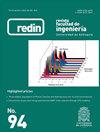医用二氧化钛支架的制造
IF 0.5
Q3 ENGINEERING, MULTIDISCIPLINARY
Revista Facultad De Ingenieria-universidad De Antioquia
Pub Date : 2018-05-20
DOI:10.19053/01211129.V27.N48.2018.8017
引用次数: 4
摘要
随着时间的推移,骨骼系统很容易受到损伤和骨质流失,因此使用自体或异体植入物是必要的。然而,这些植入物有并发症,如可提取的骨量有限和提取部位的细胞死亡;因此,生物材料已经发展成为细胞生长的平台(支架)。生物材料和骨骼具有相似的特性,可以促进材料和骨组织之间的整合,帮助组织再生。传统的陶瓷植入物是羟基磷灰石,但由于其较低的机械性能,它们已被更好的惰性陶瓷所取代。因此,本研究旨在通过多种技术制备二氧化钛支架,使用胶原蛋白、聚乙烯醇(PVA)、氯化钠和玉米粉作为粘合剂来影响孔径。通过扫描电子显微镜(SEM)对支架进行了表征,并通过模拟体液(SBF)的压缩和降解性测试对支架进行了评估。制备的支架具有在骨参数范围内的力学行为;其中,10% PVA浸润获得的支架抗压强度(6.75 MPa)、弹性模量(0.23 GPa)、孔隙率(54-67%)更接近小梁骨。本文章由计算机程序翻译,如有差异,请以英文原文为准。
Manufacture of titanium dioxide scaffolds for medical applications
The skeletal system is vulnerable to injuries and bone loss over the years, making the use of autologous or allogeneic implants necessary. However, these implants have complications, such as the limited amount of bone to be extracted and the cell death at the extraction site; hence, biomaterials have been developed as platforms for cell growth (scaffolds). Biomaterials and bones have similar properties that facilitate the integration between the material and the bone tissue, helping the tissue to regenerate. Traditional ceramic implants are hydroxyapatite, but given their low mechanical properties, they have been replaced with better inert ceramics. Therefore, this study aims at manufacturing titanium dioxide scaffolds through various techniques, using collagen, polyvinyl alcohol (PVA), sodium chloride, and corn flour as binders to influence pore size. Scaffolds were characterized by a Scanning Electron Microscope (SEM) and evaluated by compression and degradability tests in a Simulated Body Fluid (SBF). The prepared scaffolds had mechanical behaviors with ranges within the bone parameters; among them, the scaffold obtained by infiltration with 10% PVA presented values of compression strength (6.75 MPa), elastic modulus (0.23 GPa), and porosities (54-67%) closer to the values of the trabecular bone.
求助全文
通过发布文献求助,成功后即可免费获取论文全文。
去求助
来源期刊
CiteScore
2.00
自引率
0.00%
发文量
27
审稿时长
2 months
期刊介绍:
Revista Facultad de Ingenieria started in 1984 and is a publication of the School of Engineering at the University of Antioquia.
The main objective of the journal is to promote and stimulate the publishing of national and international scientific research results. The journal publishes original articles, resulting from scientific research, experimental and or simulation studies in engineering sciences, technology, and similar disciplines (Electronics, Telecommunications, Bioengineering, Biotechnology, Electrical, Computer Science, Mechanical, Chemical, Environmental, Materials, Sanitary, Civil and Industrial Engineering).
In exceptional cases, the journal will publish insightful articles related to current important subjects, or revision articles representing a significant contribution to the contextualization of the state of the art in a known relevant topic. Case reports will only be published when those cases are related to studies in which the validity of a methodology is being proven for the first time, or when a significant contribution to the knowledge of an unexplored system can be proven.
All published articles have undergone a peer review process, carried out by experts recognized for their knowledge and contributions to the relevant field.
To adapt the Journal to international standards and to promote the visibility of the published articles; and therefore, to have a greater impact in the global academic community, after November 1st 2013, the journal will accept only manuscripts written in English for reviewing and publication.
Revista Facultad de Ingeniería –redin is entirely financed by University of Antioquia
Since 2015, every article accepted for publication in the journal is assigned a DOI number.

 求助内容:
求助内容: 应助结果提醒方式:
应助结果提醒方式:


